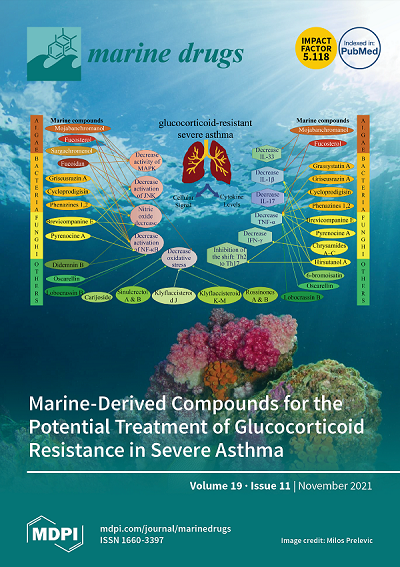分泌 pH 值和热稳定性藻酸盐裂解酶的潜在新型弧菌物种的基因组分析及其在生产藻酸盐低聚糖中的应用
IF 4.9
2区 医学
Q1 CHEMISTRY, MEDICINAL
引用次数: 0
摘要
藻酸盐裂解酶是一种极具吸引力的生物催化剂,可特异性降解藻酸盐产生低聚糖,在工业和医药应用方面具有巨大潜力。本文从中国海南琼海马尾藻中分离到一株藻酸盐降解菌株 HB236076。该菌株的 16S rRNA 基因序列同一性(<98.4%)、ANI 值(<71.9%)和 dDDH 值(<23.9%)均较低,这清楚地表明该菌株可能是弧菌属的一个新物种。基因组包含两条染色体,长度分别为 3,007,948 bp 和 874,895 bp,总长度为 3,882,843 bp,G+C 含量为 46.5%。在 3482 个基因中,预测了 3332 个蛋白质编码基因、116 个 tRNA 和 34 个 rRNA 序列。氨基酸序列分析表明,该菌株编码 73 种碳水化合物活性酶(CAZymes),预测有 7 种 PL7(Alg1-7)和 2 种 PL17 家族(Alg8、9)藻酸盐裂解酶。菌株 HB236076 的胞外海藻酸裂解酶在 50 °C 和 pH 值 7.0 时显示出最大活性,在 30-60 °C 和 pH 值 6.0-10.0 范围内测得的活性超过 90%,显示出较宽的温度和 pH 值活性范围。在较宽的 pH 值范围(3.0-9.0)和低于 50 °C 的温度下,该酶也能在 2 小时内保持 90% 以上的原始活性,表现出显著的热稳定性和 pH 值稳定性。Fe2+ 对 10 mM 的藻酸盐裂解酶活性有良好的促进作用,可提高 3.5 倍。薄层色谱(TLC)和电喷雾质谱(ESI-MS)分析表明,发酵液中的海藻酸酶可催化海藻酸钠产生二糖和三糖,对痢疾志贺氏菌、嗜水气单胞菌、金黄色葡萄球菌、无乳链球菌和大肠杆菌具有抗菌活性。该研究进一步揭示了 HB236076 型弧菌海藻酸酶的生产机理,有利于进一步应用于制备 pH 稳定、热稳定的海藻酸酶和海藻酸寡糖。本文章由计算机程序翻译,如有差异,请以英文原文为准。
Genome Analysis of a Potential Novel Vibrio Species Secreting pH-and Thermo-Stable Alginate Lyase and Its Application in Producing Alginate Oligosaccharides
Alginate lyase is an attractive biocatalyst that can specifically degrade alginate to produce oligosaccharides, showing great potential for industrial and medicinal applications. Herein, an alginate-degrading strain HB236076 was isolated from Sargassum sp. in Qionghai, Hainan, China. The low 16S rRNA gene sequence identity (<98.4%), ANI value (<71.9%), and dDDH value (<23.9%) clearly indicated that the isolate represented a potential novel species of the genus Vibrio. The genome contained two chromosomes with lengths of 3,007,948 bp and 874,895 bp, respectively, totaling 3,882,843 bp with a G+C content of 46.5%. Among 3482 genes, 3332 protein-coding genes, 116 tRNA, and 34 rRNA sequences were predicted. Analysis of the amino acid sequences showed that the strain encoded 73 carbohydrate-active enzymes (CAZymes), predicting seven PL7 (Alg1–7) and two PL17 family (Alg8, 9) alginate lyases. The extracellular alginate lyase from strain HB236076 showed the maximum activity at 50 °C and pH 7.0, with over 90% activity measured in the range of 30–60 °C and pH 6.0–10.0, exhibiting a wide range of temperature and pH activities. The enzyme also remained at more than 90% of the original activity at a wide pH range (3.0–9.0) and temperature below 50 °C for more than 2 h, demonstrating significant thermal and pH stabilities. Fe2+ had a good promoting effect on the alginate lyase activity at 10 mM, increasing by 3.5 times. Thin layer chromatography (TLC) and electrospray ionization mass spectrometry (ESI-MS) analyses suggested that alginate lyase in fermentation broth could catalyze sodium alginate to produce disaccharides and trisaccharides, which showed antimicrobial activity against Shigella dysenteriae, Aeromonas hydrophila, Staphylococcus aureus, Streptococcus agalactiae, and Escherichia coli. This research provided extended insights into the production mechanism of alginate lyase from Vibrio sp. HB236076, which was beneficial for further application in the preparation of pH-stable and thermo-stable alginate lyase and alginate oligosaccharides.
求助全文
通过发布文献求助,成功后即可免费获取论文全文。
去求助
来源期刊

Marine Drugs
医学-医药化学
CiteScore
9.60
自引率
14.80%
发文量
671
审稿时长
1 months
期刊介绍:
Marine Drugs (ISSN 1660-3397) publishes reviews, regular research papers and short notes on the research, development and production of drugs from the sea. Our aim is to encourage scientists to publish their experimental and theoretical research in as much detail as possible, particularly synthetic procedures and characterization information for bioactive compounds. There is no restriction on the length of the experimental section.
 求助内容:
求助内容: 应助结果提醒方式:
应助结果提醒方式:


